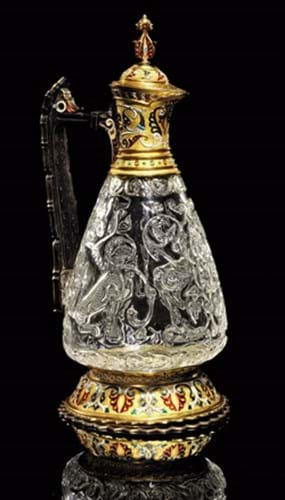
Remarkably, it has emerged that the original sale in Somerset had been annulled after doubt emerged regarding the legitimacy of a sale that the vendor, reportedly, had tried to stop as the bidding soared.
It was back on January 17 that the silver-gilt and rock crystal vessel left behind its estimate of just £100-200 to be knocked down in the room at £220,000.
The Somerset auctioneers had believed it to be a French creation from the late 19th century - a reference, no doubt, to the elaborate 'silver-gilt' and enamel mounts (they are, in fact gold with silver gilt elements) and the fitted case that carries the name of the Paris jewellers Morel à Sèvres.
However, two competing parties in the room were speculating that the rock crystal body cut with foliage and chained cheetahs bore comparison in form and decoration to ewers made c.1000 for the treasury of the Fatimid caliphs of Egypt.
But this was not the full story: ATG understands that there was some consternation as bidding rose well above the estimate and showed no sign of abating.
A high-profile trade source has claimed that the vendor, who was in the room, became alarmed, stood up and asked that the auctioneer stop the bidding and withdraw the lot from sale. The auctioneer reportedly refused the request and the lot was eventually knocked down for £220,000 amidst speculation that the item was worth well in excess of £1m.
Had proper title passed?
With this incident in mind, ATG put the scenario to specialist lawyer Milton Silverman of Streathers to establish what the legal position might be for a situation not covered by an auctioneer's Conditions of Business. In his regular legal column, on page 90 of the printed weekly newspaper ATG, June 14, he concluded that, should the matter go to trial, the court would have to rely on general auction and contract law and there would be two competing principles.
He wrote: "In auction law, the bid is the offer, which it is then up to the auctioneer to accept. If this is so, then the auctioneer is in control, and could therefore be in trouble if he does not follow his (or her) consignor's instructions to withdraw the lot.
"However, there is a separate 'offer' by the auctioneer to bidders that the highest bid wins the day, and the way that this 'offer' is accepted, causing a contract to be made, is by that highest bid. If this is the case, and a contract is formed on the bid, then of course the auctioneer cannot withdraw the lot after the bid, otherwise he will be in breach of contract."
Lawrences are now tied by a confidentiality agreement and cannot discuss the case, but in light of Mr Silverman's conclusions, it has been suggested that the vendor and winning bidder, made aware of the legal grey areas and given the potential value of the ewer, decided to come to a mutually beneficial financial arrangement, with the agreement of Lawrences.
What is clear is that the sale was subsequently made void, with the ewer being returned to the original vendor.
Christie's were approached in June to arrange a new sale by which time Lawrences' vendor had re-established full title to the ewer.
Islamic art expert at Christie's William Robinson said the 'buyer' at Lawrences no longer has a financial interest in the ewer.
Mr Robinson and Anthony Phillips from the silver department have together researched the ewer and its Islamic-inspired Morel mounts.
Their catalogue description will reproduce a letter from Jean-Valentin Morel, dated October 1854, discussing the mounting of the "crystal mauresque" at a cost of 4500 francs. The document was discovered in the family archives of the owner: the English family name is blurred, to keep ownership confidential.
Christie's describe the Fatimid ewer, which they date to the late 10th or early 11th century, as "one of the rarest and most desirable works of art from the Islamic world". Only seven fully carved surviving examples are known and this is the first and only one to be offered on the open market.
At the Art of the Islamic and Indian Worlds at King Street on October 7, it is estimated to realise in excess of £3m.
Mr Robinson dismissed reports that the ewer was available to a British public institution at £5m.
By Roland Arkell
For more information about carved rock crystal ewers made for the court of the Fatimid, click here.




